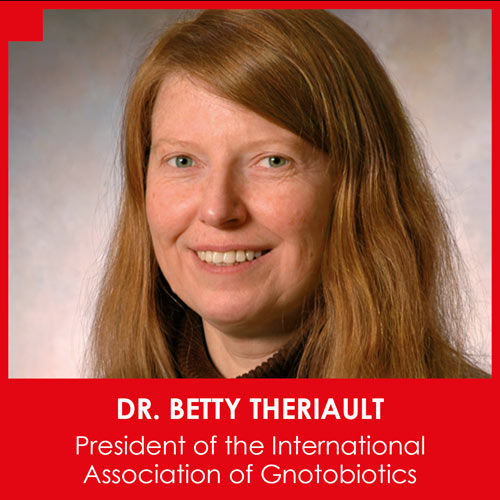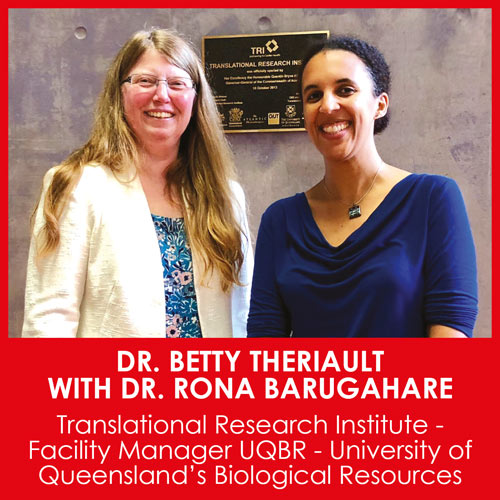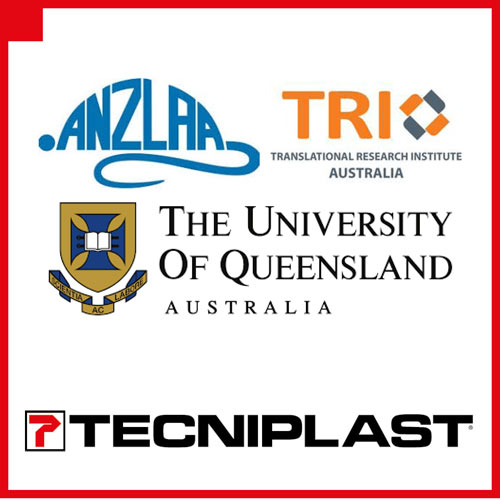
The current version of the Tecniplast website doesn't match your region. Please visit your local website to find information and offerings specific to your country.

The current version of the Tecniplast website doesn't match your region. Please visit your local website to find information and offerings specific to your country.

 Dr. Theriault illustrates the Association role, facing the Gnotobiotics challenges and market perspectives.
Dr. Theriault illustrates the Association role, facing the Gnotobiotics challenges and market perspectives.
Dear Dr. Theriault, as President of the International Association for Gnotobiology, you have recently participated at two lunch and learn sessions while in Australia for the 2018 Australia/New Zealand Laboratory Animal Association (ANZLAA) Animal Welfare Symposium. How did you find those sessions?
The lunch and learn sessions were a tremendous opportunity to meet with members of the Australian laboratory animal community and specifically members of the community interested in Germ Free and Gnotobiotic technologies. Interests of the Australian laboratory animal community certainly mirrors the spectrum of interests I am aware of in the United States and other countries, specifically, animal welfare, reproducibility, and advancing technologies. Similarly, the status of affairs as relates to germ free and gnotobiotic facilities mirrored what I am aware of in the United States and elsewhere. Specifically as example, one institution has a 20 year plus history of experience with germ free and gnotobiotic technologies while another institution has gained nearly two years of experience and yet others are just getting started in this highly specialized niche. At each of the sessions, the enthusiasm to share information and build community was quite evident and everyone was very welcoming.
 We saw a lot of interaction with key people working in GF/Gnotobiotics area. How did you find the audience?
We saw a lot of interaction with key people working in GF/Gnotobiotics area. How did you find the audience?
At each of the lunch and learns, as well as at the Animal Welfare Symposium, the audience was very receptive to information presented, highly engaged in the talks and eager to interact in open exchange. There was a lot of enthusiasm and energy; it was truly palpable.
Did you find specific interest for specific topics? If yes which ones?
Overwhelmingly, there was a general interest in new technologies and in enhancing animal welfare in our research practices. The Australian laboratory animal community had animal welfare concerns at the forefront of their interests. The community in general seemed to be eager to develop data bases to enhance study design and animal health monitoring as well as enhance daily operational practices. I found that individuals with decades of experience as well as those in early stages of their careers were eager to learn about other’s best practices and share their own. As we are all aware, we do not work in an industry where there is a “one size” or "one practice” fits all paradigm. It is through active exchange and engagement with others in our community that we are able to identify technologies, practices and applications that we can integrate into our unique programs.
 Did you find different perspectives of the GF/Gnotobiotics applications vs the US market?
Did you find different perspectives of the GF/Gnotobiotics applications vs the US market?
No, not really. Each of the facilities I visited and representatives of others all described integrated technologies and similar application concerns. Programs are utilizing isolator systems to maintain larger breeding and production colonies and are turning to hermetically sealed ventilated caging systems such as, Tecniplast’s IsoPositive system, to support specific research applications. We all share in the understanding that we are working with high risk of contamination. Utilizing technologies that are managed through strict adherence to standard operating procedures, as well as practices which each group has thoroughly interrogated before adopting, we all strive to be successful in our individual programs. Similarly, we are all dependent upon highly trained and dedicated staff members supporting all aspects of our programs, whom along with technologies, are the cornerstone of our operational success. The only real difference I noted was that of scale, with the United States simply having a larger size community than Australia. The Australian germ free and gnotobiotic community is positioned to expand with research interest growth in this specific niche, as well as in other avenues of biomedical research development. There is the old adage that quality is of much greater importance in our efforts to be outstanding than is quantity. I believe the Australian research community is well-positioned to have a significant impact on new scientific knowledge and new technology discovery.
As President of the International Gnotobiotic Association, do you think that specific events, such as lunch and learns or topic specific symposia can benefit the community?
Absolutely. Although we have technologies to connect us by list-serve and webinars and other media modalities, there is still no substitute for direct engagement with others in our communities and fostering professional relationships facilitated by these types of meeting opportunities. These activities are vital to the enhancement of our practices and in support of research endeavors. Whether primary research scientist, the laboratory animal support community or industry members in support of biomedical research, it is critical that we continue to support direct meeting opportunities. In fact, this is the specific mission of the International Association for Gnotobiology, to unite the research and support community by hosting a triennial international meeting.
How do you see the market for IVC in GF/Gnotobiotic marketing? Same trends as in the USA?
I see the same trends. Research trends and technology trends are interdependent. The microbiome is currently of international research interest. We are really just riding the crest of this new wave of discovery. We have a long way to go in harnessing the knowledge and potential that new technologies and data sets are driving. I believe that the specialty niche of germ free and gnotobiotic research is still in the early, revitalized stages relative to the demand that will be seen. Of particular interest to me is how existing and yet to be defined technologies will be utilized in the efforts to enhance reproducibility across research study designs as we embark on this new frontier in microbial ecology/microbiome research.
Vesna Valic – Tecniplast Australia General Manager